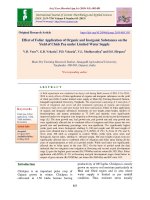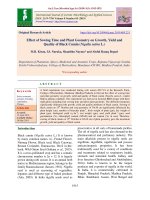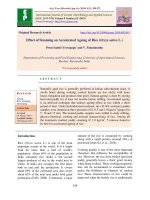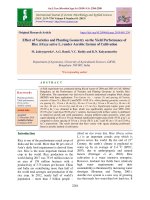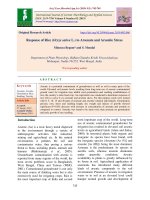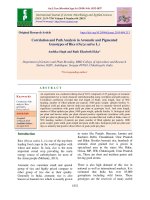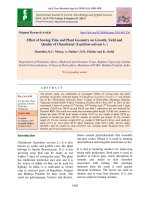Effect of varieties and planting geometry on the yield performance of rice (Oryza sativa L.) under aerobic system of cultivation
Bạn đang xem bản rút gọn của tài liệu. Xem và tải ngay bản đầy đủ của tài liệu tại đây (126.19 KB, 5 trang )
Int.J.Curr.Microbiol.App.Sci (2019) 8(1): 2284-2288
International Journal of Current Microbiology and Applied Sciences
ISSN: 2319-7706 Volume 8 Number 01 (2019)
Journal homepage:
Original Research Article
/>
Effect of Varieties and Planting Geometry on the Yield Performance of
Rice (Oryza sativa L.) under Aerobic System of Cultivation
M. Jadeyegowda*, A.G. Bandi, V.C. Reddy and K.N. Kalyanmurthy
Department of Agronomy, University of Agricultural Sciences, GKVK,
Bengaluru- 560 065, India
*Corresponding author
ABSTRACT
Keywords
Planting geometry,
Yield performance,
Oryza sativa
Aerobic system
Article Info
Accepted:
15 December 2018
Available Online:
10 January 2019
A field experiment was conducted during Kharif season of 2004 and 2005 at UAS, Hebbal
Bengaluru, on the Performance of Varieties and Planting Geometry in Aerobic Rice
Cultivation. The experiment was laid out in Factorial randomized complete block design
(RCBD) with three replications. Two factors viz. – variety (3) and spacing (6).Variety
consists of Jaya (V1), Rasi (V2) and MTU -1010 (V3), while planting geometry consists of
six spacing Viz., 30 cm x 10 cm (S1), 30 cm x 15 cm (S2), 30 cm x 20 cm (S3), 30 cm x 30
cm (S4), 40 cm x 10 cm (S5) and 40 cm x 15 cm (S6). Significantly higher grain yield
(55.95 q ha-1) was obtained in Rasi, which was significantly superior over MTU-1010
(53.76 q ha-1) and Jaya (50.58 q ha-1) varieties. Increased yield in Rasi variety is attributed
to improved growth and yield parameters. Among different plant geometry, wider and
square planting at 30 cm x 30 cm obtained significantly higher grain yield (57.02 q ha-1) as
compared to closer spacing of 30 cm x 10 cm (50.31 q ha-1) and 30 cm x 15 cm (52.94 q
ha-1) respectively. The result showed that Rasi variety with square planting performed
better in aerobic method of cultivation.
Introduction
Rice is one of the predominant cereal crops of
India and the world. More than 80 per cent of
Asia‟s daily food requirement is derived from
rice. Rice is the most important human food
crop in the world. Rice production in the
world during 2017 was 751.9 million tones in
an area of 158 million hectares with a
productivity of 3.75 tonnes per hectare. China
and India are contributing more than half of
the world total acreages and production of the
rice crop. In 2012, nearly half of world‟s
population – more than 3 billion people –
relied on rice every day. Rice (Oryza sativa
L.) is an important cereals crop which is
grown across the world. By the end of 21st
Century, the earth‟s climate is predicted to
warm up by an average of 2-4 0C (IPCC,
2007), due to anthropogenic and natural
factors (Eitzinger et al., 2010). Rice
cultivation is a water intensive enterprise.
However, lowland rice fields have relatively
high
water
requirements
and
their
sustainability is threatened by increasing water
shortages (Bouman and Tuong, 2001).
Aerobic rice system is a new way of growing
rice that needs less water than low land rice. It
2284
Int.J.Curr.Microbiol.App.Sci (2019) 8(1): 2284-2288
is grown like an upland crop in soil that is not
puddled, non-flooded or saturated. It is a
sustainable rice production methodology for
immediate future to address water scarcity and
environmental safety arising due to global
warming. Most of the rice is currently grown
in regions where current temperatures are
already close to optimum for rice production.
Yields of rice have been estimated to be
reduced by 41 % by the end of the 21st
Century (Ceccarelli et al., 2010) But, the
incidence of very variable yield and complete
yield failure were observed in dry season in
the Philippines (Kreye et al., 2007). The
optimum temperature for the normal
development of rice is ranges from 27 to 32 0C
(Yin et al., 1996). The growing scarcity of
fresh water will pose problems for rice
production in future years. Karnataka is
having substantial area under rainfed and dry
land and has a vast scope of growing rice
under aerobic conditions. There is a need for a
systematic study on the leading varieties of
rice under aerobic conditions. In this
backdrop, the present study was undertaken
with the objectives to know the performance
of rice varieties under aerobic situation and to
work out the optimum spacing which gives
higher yield per unit area.
Materials and Methods
The field experiments were conducted at
Agronomy Field Unit, Main Research Station,
University of Agricultural Sciences, Hebbal,
Bengaluru, situated in the Eastern Dry Zone of
Karnataka at 12° 58' N latitude 77° 35' E
longitude with an altitude of 930 m above
mean sea level. The soil of the experimental
site was red sandy loam in texture. The soil of
the experimental site was slightly acidic in
reaction (pH 6.7), low in available nitrogen
(180.4 kg ha-1), medium in available
phosphorus (29.4-30.1 kg ha-1) and available
potassium (220.42 to 231.20 kg ha-1). The
organic carbon content was low to medium
(0.39 to 0.40 %). Field capacity was 13.52 -
13.54 per cent, permanent wilting point was
7.83-7.90 per cent, available water 1.64 -1.65
cm and bulk density was 1.56 g/cc. The
experiment was laid out on a factorial
randomized block design replicated three. The
treatment comprised of combinations of two
factors viz. – variety (3) and spacing
(6).Variety consists of Jaya (V1), Rasi (V2)
and MTU -1010 (V3), while planting geometry
consists of six spacing Viz., 30 cm x 10 cm
(S1), 30 cm x 15 cm (S2), 30 cm x 20 cm (S3),
30 cm x 30 cm (S4), 40 cm x 10 cm (S5) and
40 cm x 15 cm (S6). After land preparation,
well decomposed farm yard manure (FYM)
was applied and equal quantity of farm yard
manure at the rate of 10 t ha-1 was applied to
each plot three weeks prior to sowing
recommended package of practices were
followed for growing the crop. Overnight
soaked seeds were manually dibbled at the
rate of one seed per hill. Weeds were
controlled by spraying Pretilochlor as pre
emergent herbicide spray @ 0.75 kg per
hectare. The late emerged weeds were
controlled by hand weeding at regular
intervals. Crop was irrigated as and when the
soil developed cracks by following alternate
wetting and drying cycles. Yellowing of
leaves was noticed initially, as a protective
measure micronutrients (Multiplex) was
sprayed @ 10 ml per liter. However from
flowering to grain filling stage soil was kept
moist by giving irrigation at three to five days
interval. The collected data on yield, plant
characters and yield related attributes were
analysed statistically by using “Analysis of
Variance Technique” and the means were
compared with the help of a statistical package
programme MSTAT-C.
Results and Discussion
The growth and yield parameters on yield as
influenced by different varieties and planting
geometry in aerobic situation as indicated in
Table 1.
2285
Int.J.Curr.Microbiol.App.Sci (2019) 8(1): 2284-2288
Table.1 The Growth and yield parameters on grain yield as influenced by different varieties and planting geometry in aerobic method
of rice cultivation
Treatment
Plant Leaf
height area
(cm)
(cm2)
/plant at
90 DAS
Varieties (A)
58.31
Jaya
64.42
Rasi
59.41
MTU-1010
0.36
S.Em±
1.08
C.D @ 5 %
Spacing (B)
60.20
30 cm × 10 cm
60.30
30 cm × 15 cm
61.20
30 cm × 20 cm
62.30
30 cm × 30 cm
61.00
40 cm × 10 cm
60.70
40 cm × 15 cm
0.50
S.Em±
1.50
C.D @ 5 %
Interaction (A x B)
0.87
S.Em±
NS
C.D @ 5 %
Dry
matter
(g) hill -1
No.
No. of
tillers productive
hill-1 tillers hill-1
Panicle
length
(cm)
Panicle
weight
(g)
No. of
filled
grains
panicle-1
No. of
unfilled
grains
panicle-1
Straw yield Test
(q/ha)
weight
Straw yield (g)
(q/ha)
Grain
yield
(q ha-1)
2038.00
2783.00
2252.00
44.40
123.10
96.60
112.90
108.70
1.18
3.54
35.28
36.64
35.67
0.30
0.90
26.69
28.58
27.28
0.29
0.87
21.31
22.94
21.83
0.14
0.42
3.35
4.00
3.83
0.08
0.24
135.00
152.00
137.00
0.84
2.33
45.00
30.00
32.00
0.60
1.65
73.38
78.24
74.10
0.81
2.26
22.89
24.89
24.58
0.18
0.51
50.58
55.95
53.76
0.49
1.35
2099.00
2386.00
2384.00
2494.00
2300.00
2378.00
62.80
174.01
101.00
105.10
105.90
113.40
105.60
104.40
1.66
4.98
34.00
35.11
35.00
41.11
35.28
34.56
0.43
1.29
25.89
26.17
26.94
31.78
27.17
27.17
0.41
1.23
21.44
22.28
22.17
22.56
22.22
21.50
0.20
0.60
3.10
3.76
3.64
4.17
3.79
3.40
0.11
0.33
139.00
141.00
141.00
148.00
139.00
138.00
1.19
3.29
37.00
36.00
35.00
32.00
37.00
37.00
0.84
2.34
72.52
74.78
76.95
81.91
75.47
76.19
1.15
3.19
23.50
24.22
24.00
25.22
24.08
23.90
0.26
0.73
50.31
52.94
54.34
57.02
53.31
52.66
0.69
1.91
108.78
NS
1.05
NS
0.74
NS
0.71
Ns
0.35
NS
0.20
NS
2.06
NS
1.46
NS
1.99
NS
0.39
NS
1.90
Ns
2286
Int.J.Curr.Microbiol.App.Sci (2019) 8(1): 2284-2288
It was revealed from the experiment that grain
yield per hectare differed significantly due to
different varieties. Rasi cultivar recorded
higher grain yield (55.95 q ha-1), which was
significantly superior to MTU-1010 (53.76 q
ha-1) and Jaya (50.58 q ha-1) cultivars. Among
different plant geometry, wider and square
planting at 30 cm x 30 cm registered
significantly higher grain yield (57.02 q ha-1)
as compared to closer spacing of 30 cm x 10
cm (50.31 q ha-1) and 30 cm x 15 cm (52.9 q
ha-1) respectively. Indeed, crop sown with the
spacing of 30 x 15 cm and 40 cm x 10 cm was
found to be on par with each other.
The average value of plant height and number
of tiller hill-1 was 91.60 cm and 17
respectively. The low aerobic rice grain yield
was due to prevail of high atmospheric
temperature during the study that affected
almost all the growth stages of rice from
emergence to ripening and harvesting. This is
in agreement with findings of Yin et al.,
(1996) and Shah et al., (2011). Spikelet
sterility was greatly increased at temperature
higher than 35 0C (Matsui et al., 1997a).
Among different plant geometry, wider and
square planting at 30 cm x 30 cm registered
significantly higher grain yield (57.02 q ha-1)
as compared to closer spacing of 30 cm x10
cm (50.31 q ha-1) and 30 cm x 15 cm (52.9 q
ha-1) respectively. Indeed, crop sown with the
spacing of 30 x 15 cm and 40 cm x 10 cm was
found to be on par with each other.
Significantly lower grain yield (50.31q ha-1)
was observed with closer spacing of 30 cm x
10cm. The variation in the yield could be
explained in terms of yield attributes.
Significantly more productive tillers per hill
(31.78) were found at wider and square
planting of 30 cm x 30cm as compared to
spacing of 40 x 10 cm (27.17) and 30 cm x 15
cm (25.89). While significantly lowest
number of productive tillers per hill was
achieved by Jaya (21.90) with closer spacing
30 cm x 10 cm. Wider as well as square
planting provided equal spacing for growth of
plants as compared to rectangular spacing.
There will be better availability and efficient
use of nutrients, moisture and efficient harvest
of solar energy by the plants in square
planting. Perhaps owing to less competition,
higher number of productive tillers was
achieved at wider spacing of 30 cm x 30 cm.
These results are in conformity with the
findings of Satyavarma et al., (1991), HuWenhe et al., (1997) and Verma et al., (2002).
Moreover, wider spacing gives room for
profuse root and tiller growth by achieving
the „border effect‟ throughout the whole field
by keeping soil moist and aerated during
vegetative growth period. Under such
conditions roots have access to both oxygen
and water due to non hypoxic condition and
non degeneration of roots during panicle
initiation (Kar et al., 1974). Obviously, it was
due to higher grains and straw yields obtained
with the Rasi variety at 30 cm x 30 cm
spacing. Similar results were observed by
Manjappa (2001), Aravind Kumar and Prasad
(2002).
The present study concluded that Rasi rice
variety grown with wider spacing of 30 cm ×
30 cm recorded higher rice grain yield ( 50 to
58 q ha-1). Hence, growing rice variety with
wider spacing is ideal for the aerobic method
of rice cultivation.
Acknowledgement
This paper forms of the part of the PhD thesis
submitted UAS, Bangalore. The authors are
grateful to Ashok Trust for Ecology and the
Environment (ATREE), Bengaluru for the
financial support during the study. The
authors also express heartfelt gratitude to Dr.
H Sudarshan, and staff of Vivekananda
Girijana Kalyana Kendra(VGKK), BRHills
for their encouragement.
2287
Int.J.Curr.Microbiol.App.Sci (2019) 8(1): 2284-2288
References
Aravind Kumar. and Prasad, N. K., 2002,
Effect
of
integrated
nutrient
management on yield and economics of
food - forage crop sequence. J. Res.
Birsa Agric. Univ., 14 (2): 237-239.
Ceccarelli, S., Grando, S., Maatougui, M.,
Michael, M., Slash, M., Haghparast, R.,
RAHMANIAN, M., Taheri, A., ALYassin, A., Benbelkacem, A., LABDI,
M., Mimoun, H. and Nachit, M. 2010,
Plant breeding and climate changes.
Cambridg, Journal of Agriculture
Science, 148: 627-637.
Eitzinger, J., Orlandini, S., Stefanski, R. and
Naylor, R. E. L. 2010, Climate change
and agriculture: Introductory editorial.
Cambridge Journal of Agricultural
Sciences, 148:499-500.
IPCC (Inter-Governmental Panel on Climate
Change) 2007, Climate change and its
impacts in the near and long term under
different scenarios. In Climate Change
2007: Synthesis Report (Eds the Core
Writing Team, R. K. Pachauri &
Reisinger),
pp.
43-54.
Geneva,
Switzerland: IPCC.
Kreye, C., Reversat, G., Fernadez, L., Vera
Cruz, C., Elazegui, F., Llorca, L.,
Faronilo, L. and Bouman, B., 2007,
Aerobic rice, a water-saving rice
production system and the risk of yield
failure – A case study from the
Philippines
in
conference
on
International Agricultural Research for
Development, University of Kassel Witzenhausen and University of
Gottinger, October, 2007, pp. 9-11.
Maheswari, J., Maragatham., James G. J. and
Martin, 2007, Relatively simple
irrigation scheduling and N application
enhances the productivity of Aerobic
rice. American Journal of Plant
Physiology 2 (4):261-268.
Manjappa, K., 2001, Effect of Azospirillum at
different levels of nitrogen on yield of
rainfed transplanted rice (Oryza sativa).
Indian J. Agron., 46(4): 643-647.
Yin, X., Kroff, M. J. and Goudriann, J., 1996,
Differential effects of day and night
temperature
on
development
to
flowering in rice. Annals of Botany, 77:
203-213.
Kar, S., Varade, S. B., Subramanyam, T. K.
and Ghildyal, B. P., 1974, Nature and
growth pattern of rice root system under
submerged and unsaturated conditions.
Il Riso., 23: 173–179.
Verma, D. K., Thakur, R., Singh, N. K. and
Mishra S. B., 2002, Heritability and
genetic advance studies in F2
population, F3 population, parents and
pooled population of Intra indica
crosses of rice. Mysore J. Agric. Sci., 36
(3): 222-230.
How to cite this article:
Jadeyegowda, M., A.G. Bandi, V.C. Reddy and Kalyanmurthy, K.N. 2019. Effect of Varieties
and Planting Geometry on the Yield Performance of Rice (Oryza sativa L.) under Aerobic
System of Cultivation. Int.J.Curr.Microbiol.App.Sci. 8(01): 2284-2288.
doi: />
2288
